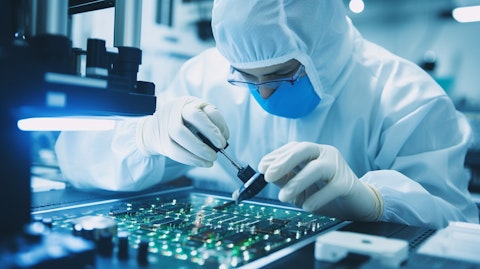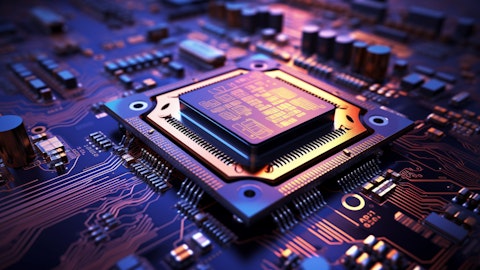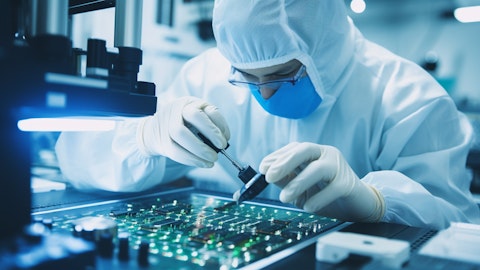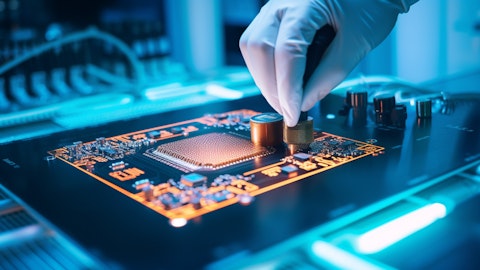Applied Materials, Inc. (NASDAQ:AMAT) Q1 2024 Earnings Call Transcript February 15, 2024
Applied Materials, Inc. isn’t one of the 30 most popular stocks among hedge funds at the end of the third quarter (see the details here).
Operator: Welcome to the Applied Materials Earnings Conference Call. During the presentation, all participants will be in a listen-only mode. Afterwards you will be invited to participate in a question-and-answer session. I would now like to turn the conference over to Michael Sullivan, Corporate Vice President. Please go ahead, sir.
Michael Sullivan: Good afternoon, everyone, and thank you for joining Applied’s First Quarter of Fiscal 2024 Earnings Call. Joining me are Gary Dickerson, our President and CEO; and Brice Hill, our Chief Financial Officer. Before we begin, I’d like to remind you that today’s call contains forward-looking statements, which are subject to risks and uncertainties that could cause our actual results to differ. Information concerning the risks and uncertainties is contained in Applied’s most recent Form 10-K filing with the SEC. Today’s call also includes non-GAAP financial measures. Reconciliations to GAAP measures are found in today’s earnings press release and in our quarterly earnings materials, which are available on our website at ir.appliedmaterials.com.
Before we begin, I have a calendar announcement. On Monday evening, February 26, Applied will host a panel at the SPIE Advanced Lithography and Patterning Conference in San Jose. Joining us will be leading experts from NVIDIA, Intel, imec and Siemens EDA. We’ll also have demo stations with several new products and technologies, we’ll be introducing at the event. There won’t be a webcast, so we hope you’ll join us in San Jose. And with that introduction, I’d like to turn the call over to Gary Dickerson.
Gary Dickerson: Thank you, Mike. Applied Materials made a strong start to fiscal 2024 with first quarter revenue in the high end of our guidance and earnings that exceeded our guided range. Our inflection-focused innovation strategy is delivering results. We have outperformed our markets for five consecutive years and believe we are in a great position as customers transition major new chip innovations to high-volume production over the next several years. The breadth of our technology capabilities, combined with our deep customer relationships, allows us to see inflections early and accelerate key technology innovations that are critical to scaling AI, IoT, electric vehicles and renewable energy. We have reshaped and expanded our portfolio of solutions that enable next-generation transistors, new interconnect schemes, including backside power delivery, high-performance DRAM including high bandwidth memory, and specialty applications in the ICAPS market.
In my prepared remarks today, I’ll provide some examples of how these inflections grow Applied’s available market and are highly accretive to our share. I’ll also talk about our long-term strategy to accelerate innovation and commercialization velocity through tighter collaboration with our customers and partners. But to begin, let me share our latest perspective on the market environment. In our discussions with customers, we’re hearing that overall market dynamics are improving. There is a reacceleration of capital investment by cloud companies, fab utilization is increasing across all device types and memory inventory levels are normalizing. In terms of Applied’s business in 2024, we see leading-edge foundry-logic being stronger year-over-year, even though some important projects are delayed.
We’re forecasting ICAPS demand to be slightly lower than 2023 with weakness in some end markets being offset by strong regional investments. We expect our NAND revenues to be up year-on-year, but NAND to remain less than 10% of total wafer fab equipment spending. And we see continued strength in our DRAM business, driven by customers ramping production of high-bandwidth memory. High-bandwidth memory where high-performance DRAM dies are stacked and connected to logic die with advanced packaging is a key enabler for the AI data center. The dies used in high-bandwidth memory are more than two times larger than standard DRAM, which means that more than twice the capacity is needed to produce the same volume of chips. On top of this, the packaging steps needed for die stacking further increase our total available market.
High-bandwidth memory, or HBM, made up only about 5% of DRAM output in 2023, but is expected to grow at a 50% compound annual growth rate over the coming years. DRAM is a great example of how our inflection-focused innovation approach is working, by focusing on the critically enabling process and packaging steps for next-generation technologies, Applied has significantly increased our share of the DRAM market. In 2023, we estimate that our DRAM share was more than 10 points higher than it was a decade earlier. And our DRAM revenues were larger than our two closest process equipment peers combined. We’re also best positioned for future growth, thanks to our leadership in logic technologies that have been implemented for DRAM peripheral circuitry applications to enable significantly increased IO speeds.
Our strong position in DRAM patterning, our unique co-optimized hard mask solutions, which are critical for capacitor scaling and advanced packaging, where we have strong leadership positions in Micro-bump and Through-Silicon Vias that will enable multiple generations of high-bandwidth memory. In fiscal 2024, we expect our HBM packaging revenues to be four times larger than last year, growing to almost $0.5 billion. And across all device types, we expect revenue from our advanced packaging product portfolio to grow to approximately $1.5 billion. Looking further ahead, we see opportunities for this business to double again, as heterogeneous integration is more widely adopted, and we introduced new products that expand our served market. Another key inflection that will transition to high-volume production beginning this year is gate-all-around transistors in leading-edge foundry-logic.
These complex 3D structures can provide a more than 30% improvement in a chip’s energy efficiency. This is especially enabling for high-performance AI data center applications. The shift from FinFET to gate-all-around grows Applied’s available market by $1 billion for every 100,000 wafer starts per month of capacity. And we’re on track to gain share and capture over 50% of the spending for the process equipment used in this new transistor module. Major advances in leading-edge foundry-logic and DRAM are also driving the need for more and better metrology and inspection to be integrated into the manufacturing flow. We have developed industry-leading cold field emission eBeam technology that enables highly sensitive 2D and 3D imaging at up to ten times higher speeds.
We expect our CFE systems revenue to grow by a factor of 4 in 2024 and represent 50% of our total eBeam system sales. The incredible innovation we see in the industry today is not limited to the leading edge. In recent years, ICAPS customers have invested about 10% of their revenues or about $30 billion annually in research and development to accelerate the roadmap for IoT, communications, automotive, power and sensor technologies. ICAPS technology depends less on shrinking device features and customer investments are heavily weighted towards new structures, new materials and new integration approaches, playing to the core strengths of Applied. ICAPS is another area where we saw market inflections early. And five years ago, we formed a dedicated team to focus on the needs of these customers.
Since then, we’ve released more than 20 new ICAPS products that target the highest value device innovations in these markets and we have a robust development pipeline of unit process and integrated solutions. While major end market inflections, such as AI and IoT, electric vehicles and renewable energy are already driving semiconductor growth and innovation, it’s important to recognize they are still in the early stages of adoption. For example, high-performance GPUs for AI data centers only represent 6% of leading-edge foundry-logic wafer starts today. The full potential of technologies like AI cannot be unlocked without next-generation chips with better performance, power and cost. The technology roadmap for semiconductors is rich with possibilities and opportunities, but also incredibly complex.
No company is better placed to address this complexity than Applied Materials. With the industry’s broadest and deepest portfolio of capabilities and products, we have a unique ability to combine, co-optimize and integrate our technologies to develop highly differentiated solutions for our customers. To bring these advances to market faster, we’re also innovating the way we innovate, by driving earlier and deeper collaboration with our customers and partners. We are expanding our global innovation network that will connect into the EPIC center we’re building in Silicon Valley. During the quarter, we announced an expansion of our long-term partnership with Leti, which is focused on accelerating ICAPS innovation, and we launched a new collaboration with MIT, which is centered around next-generation power electronics.

As industry complexity rises, we’re also delivering more value to customers with our advanced services that enable our customers to accelerate R&D, transfer new technology into volume manufacturing faster and then optimize yield, output and cost in their factories. AGS has delivered 18 consecutive quarters of year-on-year growth. Revenue for the first quarter was up 8% versus the same period last year, and the business is now at a $6 billion annual run rate. AGS has the opportunity for double-digit growth this year, and we believe we can sustain this growth rate into the future. A significant portion of AGS revenue is generated from subscriptions. We have almost 17,000 tools under service agreements, up 8% year-on-year, and these agreements have a very high renewal rate over 90%.
Before I pass the call over to Brice, I will quickly summarize. Applied Materials outperformed our markets in 2023 for the fifth consecutive year and we delivered strong results in the first quarter of 2024. The positions we’ve established at key industry inflections, will support continued outperformance, as customers ramp next-generation chip technologies into high-volume production. We are strengthening R&D collaboration with customers and partners to drive innovation and commercialization velocity, improvements in mutual success rate and R&D investment efficiencies. And we see growing demand for our advanced services that are helping customers manage increasing complexity in their business as the industry scales. Now I’ll hand over to Brice.
Brice Hill: Thank you, Gary. And I’d like to thank our teams for delivering strong revenue and margins this quarter and making further improvements in our operating performance. On today’s call, I’ll discuss our value creation strategy and the results it is producing, then I’ll summarize our growth thesis and why we believe we will outperform our markets in the years ahead, finally, I’ll summarize our Q1 results and provide our guidance for Q2. I’ll begin by discussing how our assets and strategy create value for shareholders. Applied has the broadest and deepest process equipment portfolio and expertise in the industry. We are highly invested in collaborating with our customers, allocating $3 billion in annual R&D to invent new solutions to the most critical Semiconductor manufacturing challenges.
Increasingly, the only way to solve these challenges is by co-optimizing and integrating our chamber technologies in new ways. In addition, identifying new materials and processes early and collaborating closely with customers, leads to faster results, a higher probability of success, greater efficiency and stronger financial returns. The benefits of our value creation strategy are being demonstrated in our financial results. We generated record equipment sales, $20.7 billion in calendar 2023, including legacy equipment reported in AGS. And we extended our strong position in DRAM with record calendar year sales of over $4.3 billion. In fact, over the past ten years, the company has gained over 10 points of DRAM share in multiple points of overall share.
This has contributed to Applied delivering a fifth straight year of overall WFE share gains and one of the best share outcomes of the past 20 years. Over the same ten fiscal years, we’ve grown company revenue at a compound rate of over 13%, non-GAAP EPS at nearly 30%, free cash flow at 33% and dividends per share at nearly 12%. Also, over this period, we increased return on invested capital from 8% to 35% and reduced net shares outstanding by over 30%. Next, I will summarize our growth thesis. As we look out over the planning horizon, we expect semiconductors to grow significantly faster than GDP. Second, we expect the equipment market to grow as fast or faster than semiconductors over time, driven by increasing technical complexity. Third, we expect Applied’s equipment business to outgrow the market.
And fourth, we expect our services business to grow as fast or faster than our equipment business. I’ll take a moment to support the third pillar of our thesis that Applied’s equipment business will outgrow the market. The reason is that our technologies enable the key semiconductor advances needed to drive growth in AI, IoT and renewable energy. Looking ahead to the semiconductor process inflections that will play out over the next several years, the company is extremely well positioned. In data center AI, we are number one in process equipment for advanced logic and compute memory, both standard DRAM and high-bandwidth memory. We also have line of sight to share a 50% or more in gate-all-around transistors, backside power delivery and advanced packaging.
We are equally strong in edge AI and IoT with the number one position in ICAPS silicon, which is used to sense and convert analog information and transmit it to the cloud. We are also innovating rapidly in ICAPS technology for the global energy transformation, including through new agreements with partners like Leti and MIT, which Gary described. In summary, we feel confident that our unique assets and collaboration strategy position Applied to continue to outpace our markets and deliver strong shareholder returns as these major inflections play out over the next several years. Now I’ll summarize our Q1 results. On a year-over-year basis, net sales declined slightly to $6.7 billion. Non-GAAP gross margin grew 110 basis points to 47.9%, non-GAAP OpEx grew 5.6% to $1.23 billion, and non-GAAP EPS grew nearly 5% to $2.13.
Turning to our segment results, Semiconductor Systems revenue was strong at $4.91 billion and included record DRAM and edge system sales. Segment non-GAAP operating margin was 35.7%. While our operating expenses are primarily focused on R&D programs for emerging technology inflections, we are also investing to expand and diversify our manufacturing logistics and supply chain to efficiently serve future growth. Applied Global Services delivered record revenue and its 18th consecutive quarter of year-over-year growth. AGS revenue increased approximately 8% year-over-year to nearly $1.8 billion and segment non-GAAP operating margin was 28.3%. Our installed base surpassed 49,000 tools, during the quarter and grew to nearly 200,000 chambers. Around two thirds of AGS recurring services and parts revenue was delivered as subscription agreements.
Finally, AGS continued to produce more than enough operating profit to fund Applied’s growing dividend. Moving to Display, Q1 revenue was $244 million, and segment non-GAAP operating profit was 10.2%. We continue to look forward to our opportunity in the upcoming OLED IT growth inflection. Turning to cash flows in Q1, we generated $2.3 billion in operating cash flow and $2.1 billion in free cash flow. We distributed $966 million to shareholders, including $266 million in dividends and $700 million in buybacks. We repurchased nearly five million shares, at an average price of $152.60. Please note that our Q1 results include the following. First, as we discussed in our recent 10-K report, we increased the estimated useful lives of our plant and equipment and this increased non-GAAP EPS by $0.03.
Also effective Q1, we refined the way we allocate stock-based compensation, moving the majority of the expenses from corporate unallocated to the operating segments, which gives managers greater visibility over costs. While the change has no impact on company operating profit or EPS, it reduced the segment operating profit and corporate unallocated costs proportionately. To help you with your segment models, our quarterly earnings presentation includes a table showing what operating profits would have been in fiscal 2022 and in each quarter of fiscal 2023 on a like basis. Finally, the reduction in depreciation and share-based compensation, in cost of sales, increased gross margin by approximately 40 basis points. Now I will share our guidance for Q2.
We expect revenue to be $6.5 billion, plus or minus $400 million, and we expect non-GAAP EPS of $1.97, plus or minus $0.18. Within this outlook, we expect Semi Systems revenue of around $4.8 billion, AGS revenue of about $1.5 billion and Display revenue of around $150 million. We expect non-GAAP gross margin to be approximately 47.3% and non-GAAP operating expenses to be around $1.235 billion. We are modeling a tax rate of 12.5%. Thank you. And now, Mike, let’s begin the Q&A.
Michael Sullivan: Thanks, Brice. Our goal is to help as many of our analysts as possible. With that in mind, please ask just one question on today’s call. If you have another question, please re-queue and we’ll do our best to come back to you later in the session. Operator, let’s please begin.
Operator: Certainly. [Operator Instructions] Our first question comes from the line of Stacy Rasgon from Bernstein Research. Your question please.
See also Top 16 Aircraft Manufacturers In The World and 13 Overlooked Tax Deductions for Retirees That Could Save Them Money.
Q&A Session
Follow Applied Materials Inc (NASDAQ:AMAT)
Follow Applied Materials Inc (NASDAQ:AMAT)
Stacy Rasgon: Hi guys, thanks for taking my questions. I wanted to ask about DRAM in China. So DRAM was very strong. It was supposed to be strong, but it was quite a bit stronger than, I think, we had thought it was going to be. I guess, can you tell us how much of that was China versus non-China? And going forward, last quarter, you had talked about the expectations for the China piece of that that had been pulled forward due to the sanctions to roll off as we went through the rest of the year. What are your thoughts on that China trajectory, as we go into April quarter and into the second half?
Brice Hill: Hi Stacy, thanks for your question. So in the current – in the quarter we just closed, we did see high shipments of China DRAM. And it was approximately the same in terms of the higher quantity as we saw in Q4. And just to be clear, we will expect another quarter in Q2, in our outlook quarter that it should remain elevated. I think for the Q4, we had said it was approximately $500 million increase on the DRAM side, that’s probably a good estimate for all of those quarters. And then the second part of the question, as we look through the rest of the year, we’ll expect that to normalize. Our China mix should normalize from the levels it’s at right now to something that’s more typical with our average.
Stacy Rasgon: Which is what? Is that – what’s the typical?
Brice Hill: Well, I would say from a long term – from a many year perspective, we averaged approximately 30%. So if we’re at 45% right now will decline across the year to somewhere around that level.
Stacy Rasgon: Got it. That’s helpful guys, thank you.
Brice Hill: Thank you.
Operator: Thank you. One moment for our next question. And our next question comes from the line of Vivek Arya from Bank of America. Your question please?
Vivek Arya: Thank you for taking my question. I was hoping if you could give us your view on how you see the WFE environment in 2024. I think many of your competitors have suggested kind of a low to mid-single-digit growth. But within that, the move towards more leading edge and DRAM and less on the trailing edge, but just given how strongly Applied grew in some of your trailing-edge and ICAPS, how does that position you in this new WFE environment? Because I think, Gary, you said that you only see only limited decline on the ICAPS side. But when I look at the CapEx of many of the auto industrial or analog companies in the U.S., they are cutting it quite sharply. So that’s why I was curious why you think that it’s only going to decline? So just broadly comment on WFE and the different piece parts and then maybe China versus non-China kind of cutting of that. Thank you.
Brice Hill: Okay. Thanks, Vivek. No real change, I think, in our outlook for 2024, in terms of shaping how those end markets are evolving. So, we do think DRAM will continue to be a strong market. We think NAND will improve from its low levels a little bit. We think leading logic will be larger as gate-all-around and new investments start to ramp towards the back half of the year. And we do think there will be some digestion in ICAPS in China, both. Just to be crystal clear, we had enormous growth for two years in ICAPS and the China-related ICAPS business. And so we won’t see that enormous growth this year. It may be a little bit smaller. We think there’s some digestion with that capacity. But we expect that market to grow over time along with the underlying rates for the company. So that’s – those – the shape of those end markets hasn’t changed in our outlook.
Vivek Arya: So is that consistent with the low-to-mid single-digit WFE, that others are suggesting? Or do you have a different view?
Brice Hill: Well, all we can do is tell you what we see from Applied’s perspective. When we commented on 2023, we said it was a strong year for Applied. And to the way you asked your question, we had strong ICAPS. We had strong DRAM; we were strong in growth in packaging. And so as we look toward 2024, those are the puts and takes. We’re not going to give a precise number for 2024.
Vivek Arya: Thank you, Brice.
Operator: Thank you. [Operator Instructions] And our next question comes from the line of CJ Muse from Cantor Fitzgerald. Your question please.
CJ Muse: Yes, good afternoon. Thanks for taking the question. I guess given the strong outperformance that you showed in 2023, where your silicon business actually grew where I think most people are thinking WFE down in the high single digits. Curious how you’re thinking about 2024? You’ve talked about, clearly, you’re benefiting from share gains across leading-edge foundry-logic and DRAM. But also a vision for ICAPS slowing. So do you think it’s another year of outperformance? Or is it a year of digestion, if you could kind of walk through that? And just as a kind of a bonus question, with SPY [ph] just a little over a week away, would you care to give a preview of what we’ll hear, including a focus on Sculpta? Thanks so much.
Brice Hill: Okay. So I’ll tackle the first part, and then I know Gary wants to tackle the second part of the question. So on outperforming in 2024, CJ, we do expect, because of our exposure to the fast-growing markets and some of the inflections growing quickly in 2024. We do expect to outperform. We’re not making a call on the size of the market. It’s like you said, there’s a couple of markets that are growing, the ICAPS market and the China piece, we think won’t grow. And so we’re not making a call on which is the stronger trend. And I don’t know if we know. So we’ll see how the year plays out from that perspective. And Gary, on the show.
Gary Dickerson: Hi CJ. On – just let me start on the outperformance. I think the most important thing to think about is, how we’re positioned for major inflections. So if you think about foundry-logic leading edge, gate all around, backside power distribution, those are incremental billion-dollar opportunities for Applied, where we have an opportunity for more than 50% share, which is very accretive to our overall market share. So we’re really well positioned there. ICAPS, we formed that group five years ago, as I said earlier, 20 major new products have been introduced. We have a strong pipeline of future ICAPS products. And so again, they’re – and we have opportunities to grow in segments like edge and PDC, where we have a lot of momentum.
So, I like our position in ICAPS. DRAM, we’ve gained more than 10 points of share over the last 10 years. And as I mentioned in the prepared remarks, extremely well positioned for the major inflections in DRAM. In packaging, we have the strongest and broadest portfolio. And this is around $1.5 billion of revenue for us in 2024 and an opportunity to double over the next few years. So all of those areas, I think, really set us up for continued outperformance. And then on your question about SPIE, one of the things we’ll be talking about there is Sculpta, just reminding people, that’s a breakthrough pattern shaping technology that provides a simpler, faster and more cost-effective alternative to EUV double patterning. So, we’re engaged with all of the leading foundry-logic customers and expanding Sculpta steps for advanced patterning, including High-NA EUV, and we’re also working with customers on new Sculpta applications.
And we expect this business to grow to close to $200 million in 2024, in ramp to around $0.5 billion in annual revenue, in the next few years. Also at SPIE, for those of you that will attend, you’ll hear about new edge and CVD technology for patterning that will be very large growth drivers for the company and enable us to continue to outperform. And just for reference, in patterning, we’ve increased our served market from around $1.5 billion, 10 years ago, to $8 billion now and our share from around 10% to 30%. So when Brice said, I was excited, I am absolutely excited these are some really, really great technologies with very strong customer pull and delivering meaningful growth for the company.
Operator: Thank you. [Operator Instructions] And our next question comes from the line of Chris Caso from Wolfe Research. Your question please.
Chris Caso: Yes, thank you, good afternoon. I guess the question is kind of looking at the order rates and more importantly, what your customers are telling you as you’re looking into calendar 2025. As you know, some others in the industry with long lead times have started to see some of those green shoots coming into 2025. I know that we’re balancing here between some of your customers burning off capacity and going through technology transitions. What’s the thought as we start to look into 2025, at these early days?
Brice Hill: Hi Chris, thanks for the question. When we look at the market currently, we’re seeing improvements in inventories, and we’re seeing improvements in utilization. So it’s starting to pick up. That’s pretty much across – that is across the entire market on the utilization side. And then what we’re hearing from customers is optimism, generally speaking, for 2025. We would echo comments we’ve heard from others that the semiconductor end market for devices is expected to be growing. And it’s an investment cycle on the leading edge. We’re expecting the memory markets to continue to improve. So 2025, we are optimistic about the direction for 2025.
Chris Caso: Thank you.
Operator: Thank you. [Operator Instructions] And our next question comes from the line of Krish Sankar from TD Cowen. Your question please.
Krish Sankar: Yes, hi, thanks for taking my question. Garry, I had a question for you. You have a broad-based product portfolio. You outperformed WFE last two years. I’m kind of curious for some of these new applications, whether it’s HBM, gate-all-around or even backside power delivery, are customers looking at a one-stop shop? Or more going with best-of-breed solutions? And in other words, let’s say, for gate-all-around, is your strength in Epi helping your edge or ALD products?
Gary Dickerson: Yes. Chris, one thing I would say that for all of these inflections, it’s a tremendous advantage for us to have that broad portfolio. Again, when you think about – one of the examples I’ve used many times is, your processor chip and your smartphone with 15 billion transistors and 60 miles of wiring, which is kind of mind-boggling, when you think about how do we do that? How do we create something like that. There are over 1,500 steps in building that type of chip. And when you’re developing these new technologies, like gate-all-around, like backside power or new DRAM technologies or any of these packaging technologies, the ability to combine and co-optimize these steps is an enormous advantage, enormous that 60 miles of wiring, we have one platform that combines seven technologies under vacuum, to enable that those 60 miles long, very thin wires to move the data at super high speeds, very low resistance and very low power.
So it’s completely unique. And that’s about one-third of our portfolio are those integrated solutions. We also have clear leadership in eBeam technology. I talked about our cold field emission electron optics. And that enables us to see those structures, when you’re building gate-all-around, and you want to look at the width of those nanosheets, again, we have unique technology that enables us to learn faster and then we can co-optimize all of those technologies. So as we’re driving our innovation with customers, we’re deeper, we’re earlier, we can see four generations out, relative to those technologies. So super, super deep connectivity. That’s why also I think EPIC is going to be a game changer in how we innovate, the way we innovate.
We talked about the relationship with Larry [ph] for innovation and edge computing and ICAPs, all of those things, then we have our advanced packaging lab in Singapore that is also a full flow lab, where customers are working on innovation and new architectures. So Chris, I think that gives us a tremendous advantage. We can see what’s needed earlier. And then the ability to co-optimize all of that gives us a tremendous advantage.
Krish Sankar: Thanks, Gary.
Operator: Thank you. [Operator Instructions] And our next question comes from the line of Atif Malik from Citi. Your question please.





